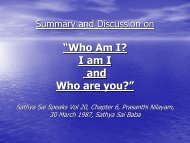Gyani Baile & Dolly Baile
Gyani Baile & Dolly Baile
Gyani Baile & Dolly Baile
Create successful ePaper yourself
Turn your PDF publications into a flip-book with our unique Google optimized e-Paper software.
sees God in everything and everywhere. Eventually the devotee reaches<br />
Divinity in the form of Ishta Devata who is one aspect or form of God.<br />
Bhakti in its ultimate form binds the devotee to God, without any<br />
restrictions of caste or color, and without any rules for worship.<br />
Chanting of Divine name, Japa and Stotra<br />
Before going through <strong>Dolly</strong>'s inner experiences we had this wrong<br />
notion that the purpose of chanting was to please God. Our minds could<br />
never accept that notion, and as a result we could never full heartedly<br />
engage in any those activities. Later we learned that the purpose,<br />
accurately, was deeper and three fold: one purpose is invocation of the<br />
deity; second purpose is to cultivate inward concentration and third is to<br />
keep the devotional fervor up.<br />
The chanting of divine name has an important place in the Bhakti<br />
Yoga. Name chanting is done in the name of Japa, Stotra and Bhajans.<br />
Japa is the silent repetition of a single divine name e.g. Om Namah<br />
Shivaya, Hare Krishna, Hare Rama, etc. or it can be a long formula<br />
which is called a mantra like the Gayatri Mantra (described below). The<br />
stotra, on the other hand, is loud chanting of verses conveying the glory<br />
and attributes of the Divine. The chanting of stotras is done mostly by<br />
individuals alone or sometimes in the company of a few. There seem to<br />
be Sahasranama (thousand names) Stotras in praise of the most of the<br />
deities in the indu Hindu pantheon. The two most popular Sahasrnama<br />
Stotras are Vishnu sahasranama (in praise of Lord Vishnu) and Lalitha<br />
Sahasranama (in praise of deity as the Divine Mother). The Bhajans<br />
(also called kirtans), which are songs conveying the names and attributes<br />
of the Deity, which are sung by a group people. All the three forms of<br />
chanting are for the invocation of the divine. Among these different<br />
chanting options, she went in full circle on doing each in different time<br />
slots according to the prompting she received from within.<br />
Gayatri Mantra:<br />
The Vedas (most ancient and authoritative scriptures of Hindu religion<br />
and philosophy) are full of mantras of great thought powers which have<br />
come from nada or sound. There are various kinds of mantras, Vedic<br />
126



